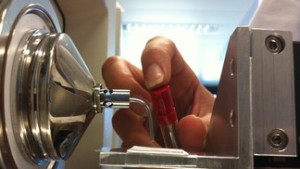Sep 25 2013
Scientists at EPFL have designed a quick method for detecting counterfeit perfumes, and have tested it on major brands like Givenchy, Hermes and D&G.
 © 2013 EPFL
© 2013 EPFL
Counterfeit perfumes are costing the cosmetic industry and consumers significant amounts of money. But identifying imitation perfumes can be a difficult and time-consuming task despite a number of available analytical techniques. Publishing in Rapid Communications in Mass Spectrometry, EPFL researchers have developed an innovative method called Electrostatic Spray Ionization that can analyze and identify counterfeit perfumes faster than conventional methods.
Six fragrances from well-known manufacturers including Givenchy, Hermes and D&G were tested by the team of Hubert Girault at EPFL using their novel detection method (ESTASI). The commercial fragrances were analyzed and compared to a ‘model’ perfume made up of ten different compounds. The results showed that the new method was able to quickly distinguish between authentic perfumes and their ‘model’ counterfeit. Because there is no need for time-consuming preparations of the samples before testing, the new method provides a rapid, high-throughput means of fingerprinting and identifying perfumes.
The first, and often most challenging step to analyzing a chemical is to ionize it; that is, to break it up into smaller pieces that carry an electrical charge. This is usually done by turning these fragment ions into a fine spray, which is why this process is called “electrospray ionization”. The ions are then analyzed by a detector that records the electrical charge of each passing ion. The result is a ‘fingerprint’ pattern that is unique to the tested sample and can be compared to fingerprints of other samples. This makes it possible to determine the elements that make up almost any chemical, including proteins or other complex compound.
Elena Tobolkina et al. developed an electrospray ionization method called Electrostatic Spray Ionization, where the sample to be tested is charged like a capacitor (an electron-storage device). This results in the sample’s fragmentation, followed by the release of ions as a spray. The advantage of this approach over conventional electrospray ionization methods is that the samples require minimal or no chemical preparation in advance. That means that the analysis can be faster, real-time and can generate more data.
The EPFL researchers tested different commercial perfumes and a ‘model’ perfume made with ten ingredients commonly found in cosmetic fragrances. Depending on their format (liquid or spray), the perfume samples were loaded onto commercial blotting paper (Chanel), lint-free paper, or they were sprayed on regular, store-bought perfume strips. One perfume was even tested after being applied on skin. The final data were then compared to those obtained with conventional electrospray ionization methods.
Although still at a proof-of-concept stage, the study’s authors foresee this method being applied in a wide range of areas in perfume manufacturing, including quality control of perfumes to minimize counterfeiting, as well as in the development of novel aromatic and natural compounds that form the basis of perfumes, thereby increasing the productivity of the perfume and cosmetic industry.
Reference
Tobolkina E, Qiao L, Xu G, Girault HH, 2013. Electrostatic-spray ionization mass spectrometry sniffing for perfume fingerprinting. Rapid Commun. Mass. Spectrom. 2013, 27:1-7.